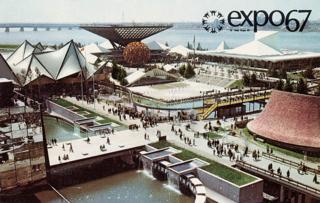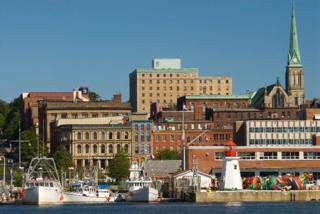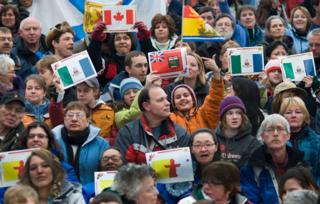Canada 150 & Me – Canada:A Mosaic

 In the summer of 1967, I made my first ever trip out of the Maritime Provinces. I took the train to Montreal for Expo 67, celebrating Canada’s 100th birthday and my own 21st birthday. Having successfully completed three years of my B.Sc. degree in Chemistry, I felt ready to take on the world! But, with no money to travel the world, the "Universal and International Exhibition" seemed like a good second choice!
In the summer of 1967, I made my first ever trip out of the Maritime Provinces. I took the train to Montreal for Expo 67, celebrating Canada’s 100th birthday and my own 21st birthday. Having successfully completed three years of my B.Sc. degree in Chemistry, I felt ready to take on the world! But, with no money to travel the world, the "Universal and International Exhibition" seemed like a good second choice!
Each day I visited the pavilions of various countries and took in cultural activities; dutifully collecting stamps in my Expo Passport at each stop. I felt like the proverbial kid in a candy shop. In a real sense the world had come to Canada. Moshe Safdie’s Habitat ’67 showed that better and cheaper housing was possible with modular construction. Buckminster Fuller’s geodesic dome (the USA pavilion) showcased another new way of building. 
The German pavilion was a spectacular 15-storey, multi-peaked tent of white plastic. But, what I most recall, as I think back to those days, is the collection of distinctive pavilions from around the globe; each featuring staff in national dress who introduced visitors to their unique culture and cuisine. I had my first Indian curry dish at Expo!
On a recent visit to Montreal, I visited the old Expo 67 site. Today, much of it is used for recreation and only a few of the 1967 buildings remain; notably the burned-out Buckminster Fuller geodesic dome and the former French pavilion which is now Montreal’s casino. As I wandered around, I began to think about how much I and Canada had changed since 1967.
I think that the biggest change in me, and perhaps in Canada, over the past 50 years has had to do with culture and religion. In 1967, I thought of Canada as largely populated by emigrants of English and French descent. I grew up in a working-class neighborhood; comprised mostly of families with grandparents who had come from Britain or Ireland. My own grandfathers were from Scotland and Wales.
 For the most part, the population was either Protestant or Catholic. In fact, in Saint John, we referred to the schools as Protestant (named after members of the royal family alive or dead) or Catholic (named after saints). Visiting my old high school last summer, I was struck by the fact that, with just a couple of exceptions, my 1964 graduating class group photo was not just all Catholic, but practically all white. The more recent graduation pictures, of course, are far more reflective of Canada as a multi-cultural society.
For the most part, the population was either Protestant or Catholic. In fact, in Saint John, we referred to the schools as Protestant (named after members of the royal family alive or dead) or Catholic (named after saints). Visiting my old high school last summer, I was struck by the fact that, with just a couple of exceptions, my 1964 graduating class group photo was not just all Catholic, but practically all white. The more recent graduation pictures, of course, are far more reflective of Canada as a multi-cultural society.
The idea of Canada as a “mosaic” in which each cultural and religious group retains a distinct identity and still contributes to the nation as a whole, became part of Canadian multiculturalism policy in the 1970s. I would say that this notion, coupled with the many changes that occurred in the Roman Catholic church and Society of Jesus since 1967 (Vatican II, of course, and GCXXXII-XXXIV) [1] were major – broadening — influences on my formation as a Jesuit and as a Catholic priest. 
In 1982, I was assigned as the chief administrator of Saint Paul’s High School in Winnipeg; with a student body reflecting the vibrant cultural diversity of Winnipeg. The Board Chair, in fact, was a Jewish business man who had attended St. Paul’s in the 1950s (unusual at that time!). I soon felt like an ‘adopted’ member of his family; attending Synagogue with them for his son’s bar mitzvah. A few years later, I was a founding member of a Jewish-Catholic dialogue group of Jewish rabbis and Roman Catholic priests which met monthly.
 When I moved to the University of Manitoba in 1988, I began to teach a graduate course in the Faculty of Education which focused on “religion and education”. I soon discovered that some of my students were active Muslims, Hindus and Buddhists. Through them, I was invited to attend celebrations at their places of worship and began inviting leaders of different faith groups to speak to my classes.
When I moved to the University of Manitoba in 1988, I began to teach a graduate course in the Faculty of Education which focused on “religion and education”. I soon discovered that some of my students were active Muslims, Hindus and Buddhists. Through them, I was invited to attend celebrations at their places of worship and began inviting leaders of different faith groups to speak to my classes.
Over time, I began taking student groups to early night prayer (Salat al-Isha) at the large mosque in front of the University of Manitoba and to pujas (“adoration”) in a nearby Hindu temple. These encounters drew me into the sphere of interfaith dialogue.
Reflecting back over the past 50 years, I can see that Canada has grown from its rather narrow colonial roots (my home town of Saint John was known as the Loyalist City) into a tolerant mix of cultures and religions who live remarkably well together. I am proud to be a part of multicultural Canada.
+++++++++++++++++++++
[1] General Congregations 32 and 34 of the Jesuits.




No Comments